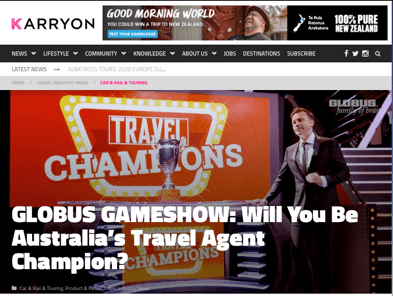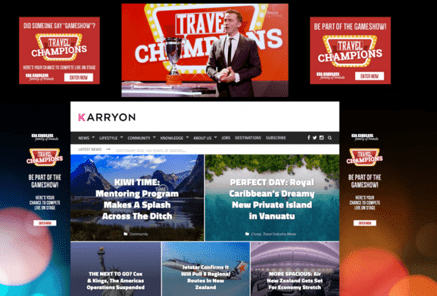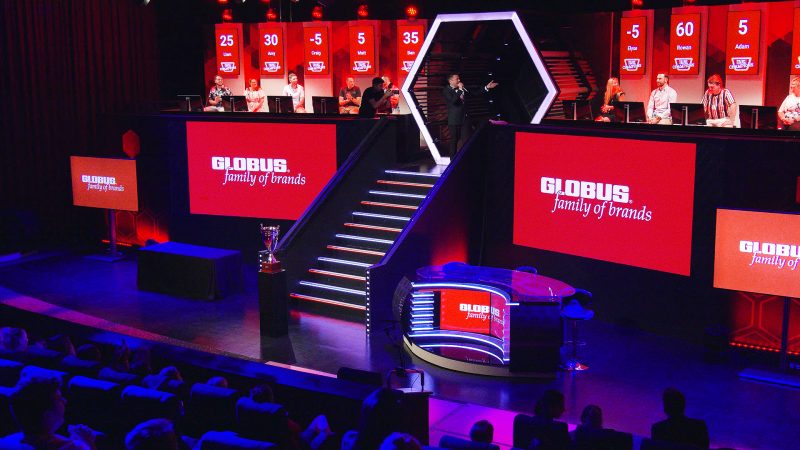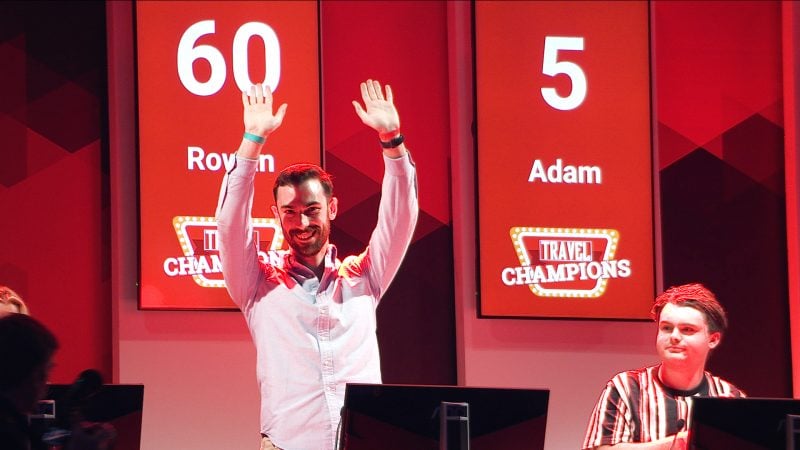The travel industry has taken a big hit through the recent bushfires and now the uncertainty within the industry has doubled with the global coronavirus concerns.
Australians have a fantastic optimism bias, where we sometimes choose to bury our heads in the sand and hope it will all go away. Unfortunately, this is not one of those times.
It’s a time for travel brands and the industry to step up and take action.
Here three starting thoughts from a business and content perspective:
1. Build Trust through Transparency
Loyalty begins with trust, and the best way to build trust is by highlighting the steps your business is taking to ensure customers who travel with you will be as safe as possible in this uncertain time.
- Set out an action plan within the business and then have your leadership team share the actions you are taking as a business through highly transparent content.
- Keep this content up to date with weekly updates via video EDM and social to inform customers of action you are taking as the situation changes week by week across the globe.
- Have a strategy to hold onto customers long term if they decide to cancel planned holidays due to the virus.
- Explain in detail the health regulations you have put in place for each customers safety
- Be Authentic – share your vulnerability and concern, but in a way that reinforces the business is far from putting its head in the sand over the situation.

2. Don’t Hold Back
Customers are constantly looking at new inspiration and content. While the first reaction may be to cut back on your marketing and content creation, it’s a time to dial up your content presence. Hold true to your tone of voice and the product attributes your brand offers customers.
People are still engaging with content and planning – they may decide to put off the trip in the next 6 months, but book for ’21. So, it’s important that you are top of mind as ever. By continuing to deliver the same level or dial up marketing & content during a downturn, you’ll already be ahead of the race to reap the benefits at the start of the upswing.
3. More than an Offer
Now is the time to highlight your points of difference and entice audiences to engage with the brand. While competitors may retreat and approach with caution, one of the best approaches to surviving uncertainty is to set yourself apart and dialling up the experience and added value that comes with your brand – the things your business is famous for. Think about this beyond a discount offer. Who can you collaborate with? What other innovations do you have in the pipeline that you can fast track?

At 3rdspace, we talk about helping brands with purpose create content that provokes action. Now is a time for dialling up why your business exists (your core purpose) and creating compelling and authentic content that brings that purpose to life, so that your potential customers want to engage and book with you when they do decide to take that holiday
If you’re interested in finding out more about this approach and how your brand can come through this storm in good shape, please drop me a line.
We’d love to discuss your business.
Rob Logan is the founder and Content Director at 3rdspace - The Content Company.
Change is inevitable. It’s what has shaped every aspect of life as we know it. Whilst change can seem scary at first, the most successful people are those who take opportunities for change and use it to their advantage by forcing themselves out of the comfort zone.
Establishing and enforcing new process and ways of thinking can seem unnecessary and resource inefficient – particularly when current processes are working. However, it is important to remember that failure to change means that your business will be left behind.
At 3rdspace we’re always looking to reignite our purpose, learning from our wins and most definitely our mistakes. Here’s three key drivers to fostering an open-minded, change-centric culture.
ONE: Just because it works for you, it doesn’t mean there isn’t a better way of doing things.
We’re all guilty of it. We have a strategy, a way of thinking or one route that gets us to where we want to go. But what if there was an express route? Starting small and considering new perspectives will harness your change-centric mindset and allow you to personalize whatever it is you chose to apply this mindset to. From a content perspective engage in thought provoking conversations with specialists in the field to understand the perspectives and processes of thought leaders and gain knowledge to shape your content strategy to drive greater results.
TWO: Foster a data-centric culture.
Almost every single day, we hear about the importance of data. However, it isn’t the data which will benefit your business- it's the way in which it’s used. Analyze data and use it to establish and shape the identities of your audience personas. Determine who your audience is, not by assuming from industry, but rather, understanding who is engaging with your content, on what platforms and how that engagement is nurturing new clients for your business.
Adobe pledged to stay ahead of the game, implementing the concept of the ‘subscription economy’. Whilst most businesses neglected change, Adobe has taken advantage of an eager market hungry for doing things differently and its sales skyrocketed. Fostering this data centric culture allowed Adobe to understand the value of this investment assisted by data backed forecasts. The results speak for themselves!
THREE: Look at the scoreboard.
It’s easy to think that our ways are the best- at least the best for ourselves. It’s not uncommon to hear businesses preaching about their great strategy or product that you need. From a content perspective brands often get caught up in vanity metrics. We need to be thinking about results results results, How those engagement metrics and brand building content campaigns are also nurturing new data – new leads and new opportunities for the business.
In 2020 it’s one of the most exciting times in content marketing, so if you’d like a fresh opinion and some more information on what we see happening in the world of content, we’d love to chat about how your content can provoke consumer action
Talk to us here
What are Insta stories?
Instagram stories provide a short glimpse into share-worthy moments. Whether it’s a fun team lunch, updating your customers on your newest collection installment or back in stock items, Instagram stories connect you with your audience on a more personal and spontaneous platform.
Since its launch in August 2016, countless features and functions have been introduced, making it one of the most effective forms of both organic and paid media.
How many people are really using them?
Instagram stories are visited by half a billion users each day. In 2019, the list of brands on Gartner’s Social platforms and influencers report, saw a 13% increase on brands using the feature from 2018.
How should you use them?
Swipe up links are an easy way to direct consumers to your website, encouraging buying behaviour through product education (keep in mind that your account needs to have at least 10,000 followers to have access to the ‘swipe up function). Boost audience engagement on your stories with polls and questions, reactions and swipe up messages. Swiping up on stories allows users to engage in direct messaging, also known as ‘Instagram Direct’ which has evolved to become one of the most popular messaging apps to date, drawing in 375 million users. According to TechCrunch, one in five Instagram stories shared by a brand receives a direct reply, facilitating direct audience contact.
Story highlights on your profile page allow brands to save notable stories. Bulk relevant stories together in labelled categories. Small icons can be used to quickly identify what the stories contain. Be sure to keep your highlights to a minimum, about seven highlights is usually enough to cover all your content and not overwhelm your audience.
Stories are also an effective way to post trends and news segments within your industry. For smaller news breaks that need to be sent out quickly, or that aren’t big enough for an entire blog post, put it up on your story. Add a questions sticker or a trending hashtag to encourage engagement. And that’s it! Your brand is now a go-to for up-to-date industry news.
So, whatever industry your business falls in, and with this handy cheat sheet, we’ll be sure to keep an eye out for your daily Instagram stories.
Cutting through the overload of ordinary content clutter is a challenge we take to heart at 3rdspace. This was a first for us and a first for the industry too. We’ve just launched Australia’s First Travel Industry Gameshow!
Travel agents from across the nation turned out for the coveted battle for Globus family of brands’ Travel Champions title. The nation’s top travel agents took to the stage as TV presenter James Kerley put them through their paces, quizzing contestants on geography, travel and their product knowledge about the Globus family of Brands: Avalon Waterways, Globus, Cosmos and Monograms. It’s wasn’t a poll or a quiz. It was a real live Travel Game Show!
The Background
A large percentage of Globus Family of Brands holidays are sold through travel agents – they are a vital part of telling the brand’s story. We needed to find an innovative way to inspire them to want to tell that story and build their product knowledge about the Globus family of Brands: Avalon Waterways, Globus, Cosmos and Monograms. To do this we needed to firstly step back and look at the cultural context.
The reason so many people are attracted to the travel industry is not just that “they love travel,” but that they also love dealing with people and being well-informed about the wonderful places and experiences in this beautiful world. And most importantly, being involved in an industry that allows you to have some fun along the way!
The 3rdspace Approach
90% of the content in the entire world was generated within two years alone (Forbes, 2018). With no signs of stopping and statistics increasing each year, it becomes even more important to have a strong content strategy that brings the brand’s tone of voice to life in a way that is different from the competition and involves the audience.
The approach is still the same. Ensure the content lines up with our strategy and the Globus Family of Brands’ content mission that allows you to ‘Go Live It’. We also needed ensure it reflected the brand’s tone of voice. Most importantly in the execution, we really needed to think about how we could provoke action and involve the audience.
Sourcing the Contestants
An
initial launch film was amplified to travel agents across the country, creating
hype and driving them to a dedicated competition microsite where travel agents were
required to answer a series of travel related questions to qualify to be a part
of the game show.
Teams featured travel agents from all states and territories across Australia,
including representatives from Flight Centre, Bicton Travel, Helloworld, Travel
Managers, italk travel, Devonport Travel & Cruise and RAA.
Trade Support
Industry trade site KarryOn was excited to come on board as the exclusive trade media partner for this truly unique event and helped to build anticipation and excitement for the event right up to the night. With access to a limited number of passes to the chic pre-event party at Urban Winery and seats in the studio audience, KarryOn ensured travel agents knew it was the hottest ticket in town!
The Gameshow
Our ten teams headed to our purpose-built TV game show set in Sydney, ready to compete in front of a live studio audience of industry peers, to become the Globus Family of Brands’ Travel Agency Champions.
After a gruelling six rounds of tough questions, it was Pat McKinnon and Liam Lavery from Flight Centre Ballarat that took home a trophy; winning an amazing night out for their whole agency and most importantly, the prestige of being dubbed the best in the business.
Following the team competition, it was time to determine who would take out Globus Family of Brands’ Travel Consultant Champion. Five individual consultants were randomly selected and invited to “Come On Down” from the studio audience to battle it out against the top five contestants from round one.
Round two saw some intense competition but ultimately it was Rowan Muller from Flight Centre Marion that triumphed, scoring themselves a luxurious river cruise for two with Avalon Waterways.
The Response
The feedback and engagement within the travel industry has been fantastic, including take overs on industry travel blogs, a massive wave of entries and hyped conversation on industry social sites. A dedicated amplification plan ensured our event content would receive extensive coverage across the travel industry with social amplification providing even greater scale during and post the event.
Globus Family of Brands Director of Marketing Chris Fundell said “3rdspace had the answer and we absolutely loved working with them for their non-traditional approach. They knew just how to capture the attention of our audience in a way we know will have a lasting impact, communicating our key messages in an extremely entertaining way.”
Like to hear more?
We look forward to partnering with ambitious and brave brands like Globus to create more innovative projects in the future. This is an example that we hope may inspire you to do your content marketing differently to the rest of the pack. If you’d like to know more about how it came about, drop us a line.
Aussies love a bit of a skirmish - that’s why we love sport.
If we look at why we love sport, there are some insights that can help brands cut through with their content marketing strategy.
Be brave - Be bold
We’ve just come out of 2 weeks of football finals. The teams that made it to the grand finals were the ones who not only had a strong strategy, but also were prepared to pivot if their game plan was being blocked.
It’s very relevant when it comes to a content marketing strategy - months out, the plan may have looked solid, but when it goes live, it’s not ticking all the boxes you wanted it to. In sport they are AB testing all season - the same goes with your content. If you are having viewer drop off or not getting the involvement planned - be bold and not only AB test but ABCD, re-edit, re-design... and also try things that are not considered “best practice”, as the commentators don’t know everything.
Take it up to the opposition
A bit of friendly heckling will cut through.
As much as we love the skills of the players, we love it when there is a bit of friendly heckling - and when things are not right the fans let the umpire know.
When we ran an audit on the LinkedIn platform of the most engaged content over 3 months, on top was a piece talking about Aldi smashing Coles and Woolies, proving audiences even in a business environment love a bit of a stouch. If it’s done with humour even better; for example, the way Burger King take it up to McDonald's in Europe - but for some reason in this territory, everyone wants to play so safe.
Going up against a leading brand is not for the faint hearted , but if you have the proof points, it can be a way to reposition a brand and cut through with a challenger content strategy very quickly, and if your content is speaking a truth, people will pick up on it and share.
Celebrate your stars
Yes there is the contest; but sport, like content, is all about establishing who your stars are, whether they be the leader of the business, a personality/influencer, a great piece of creative, your staff or a customer. It’s all about not only highlighting them but also the back story and why they are so relevant to your brand, like the story of Marlin Picket debuting in the grand final for Richmond... it almost became as big as the win itself.
Build a culture that supports the fans and involves them in the game experience
The legendary Kevin Sheedy is a coach that does this better than anyone else, with initiatives way back, like the mums supporter group, that was all about creating community events for mums away from football at the club. I’m sure you can think of a piece of content in sport where a star has taken time to do more than sign an autograph. Make sure your content really works hard to involve the audience, but make it look and feel effortless and genuine.
Admit when you screwed up
A great coach and team will admit when they got the play wrong, as in content marketing. A day in social can be like a lifetime, so if something does go wrong, own it, apologise for it and take immediate steps to fix it. This one may also be useful for a certain referee who called six again on Sunday night...
We can talk content marketing and sport all day, so if you’d like to chat contact us here.
Unless you’ve been living under a rock, you’ll already know that Instagram recently started removing the ‘likes’ count from its in-app experience, coming as a shock to Insta-lovers and influencers alike.
Now Facebook, Instagram’s parent company, is following suit by also testing the removal of the likes count, starting this month in Australia. Much like the Instagram change, soon Facebook users won’t be able to see the total number of likes on posts other than their own. This change is aimed at making the platform ‘feel less like a competition’ – demanding a re-focus on Facebook’s purpose of personal content-sharing, rather than posting content for the sake of driving popularity.
The decision to trial the removal of the like count on the Facebook platform comes from “a positive overall trend across both of the platforms” and to “help people focus less on likes and more on telling their story” says Mia Garlick, director of policy at Facebook ANZ. “We want to see whether removing the visibility of the likes and reaction count increases the value that people find when they’re connecting and sharing on Facebook. So do people find that this helps them focus on the quality of the interactions, rather than getting distracted by the quality of likes and reactions?”
Since the emergence of social media in the mid-2000’s, ‘likes’ have quantified our popularity across social platforms almost as much as a brands’ follower count or subscriber list. The linking of the two - popularity and likes - has become a visual representation of an influencer or brand’s validity and trustworthiness – the higher the number of ‘likes’ on a post, the more ‘social credibility’ the user has won. Data derived from ‘like’ and engagement metrics may indeed mean that content is great or highly engaging, but this isn’t always the case. Time and time again we’re noticing content out there that isn’t great but has a lot of likes. Why? Well, it’s no secret that services that enable buying likes and followers exist – in fact, so many people and businesses seem to be doing it, that ‘like’ metrics have largely become unreliable measures of a post’s true traction. This is no doubt one of the reasons at the forefront of Facebook and Instagram’s decision to remove the metric altogether.
But what does the removal of the likes count mean for content creators? The hope held by Instagram and Facebook is that by removing the emphasis on likes, users will be encouraged to post more “authentic” content, without worrying about how many likes it gets. For content creators, the removal of the like count may mean an increased frequency in posting and activity on social media platforms due to less “posting pressure” to only post content that’s likely to garner likes. Where we once lived in a world that only rewarded truly engaging content with a double-tap or a thumbs-up, we can now throw all caution (and care) to the wind and post content that we truly want to post – regardless of whether we think it will prove to be popular with the likers. Does this mean brands should start posting five times a day, no matter how valuable the content? Absolutely not.
Successful content creators know that when it comes to sharing content, quality will always trump quantity. Just because your audience can no longer keep an eye on how many likes your posts are accumulating certainly doesn’t mean you should post every BTS photo your business can produce. If anything, the removal of the likes count should come as a signal for brands to focus on posting quality content with purpose that is really going to resonate with the audience they’re trying to reach. With ‘likes’ becoming such a casual vanity metric (think of how many times you’ve ‘liked’ a post without looking at it for longer than 3 seconds), it’s no surprise that Instagram and Facebook are nudging content creators to consider moving beyond the ‘like’ metric in the hopes that they’ll strive to achieve results with meaning. Moving forward, considering the engaged audience’s demographics and rate of click-throughs will become powerful indicators of a content campaign’s success.
At the end of the day, content creators need to remember that behind that ‘like’ button sits a human being who is physically engaging with their content. Beyond the ‘like’, businesses need to be considering what value their content adds to the lives of their audience. We can hope that as a result, we start to see a reduction in the amount of ‘engagement-bait’ posts – “double-tap if you agree!” – and an increase in content that actually makes social media a good place to be.
Do you believe in life after likes?
What’s the goal of any piece of content? To get it in front of human eyes, engaged with, loved and shared, ultimately with the aim that this beautiful little piece of content is going to bring your client some serious ROI. Fellow content marketers will all agree that creating winning content that successfully elevates a brand and provokes action is no simple task. It takes a powerful strategy, a huge amount of creativity, commitment... and it also helps to have super talented staff on your team.
So, let’s say you’ve got the perfect formula, and your campaign is well underway being seen, engaged with, loved and shared by your target audience. Is that enough to call it a win and pat yourself on the back? Not exactly.
Without sinking your teeth into the nitty gritty performance metrics of your campaigns, you can’t possibly know how well it’s REALLY doing. Sure, likes and shares are great, but to really paint a picture of how a campaign is performing, businesses need to look beyond the “fluff” or vanity metrics and heed the content metrics that are genuinely affecting the client’s bottom line.
There are hundreds of different marketing metrics your business can measure, and while we’re believers that all data is useful when it comes to measuring ROI in our campaigns, we’ve picked our top five key metrics that you need to be keeping an eye on to track the performance of your work. The good news is, all of these metrics can be broken down into simple measurable stats, all of which can be tracked through a basic Google Analytics account and by diving a bit deeper into the platform analytics that you are publishing on. Let’s dive in.
Views
This may seem like a no-brainer, but knowing how many times a piece of content has been viewed is a great insight in determining which videos/ posts really resonate with your audience and which ones miss the mark. Other useful metrics in evaluating the popularity of your content is to compare total views with unique views (this lets you know how many times the content was reloaded). We also like to look at completed views and when viewers dropped off in films.
Sources of Traffic
All your traffic comes from somewhere, and knowing where your audience is coming from is key when strategising how best to amplify your content. The three primary traffic sources you’ll see in your metrics report are direct (when visitors type your URL into the search bar), referral (when visitors find your site through clicking a link on another site), and search (when visitors find your content through searching certain keywords on a search engine like Google), although you’ll likely also have traffic from banner ads and paid search if you’re investing in SEO and ads. To harness this metric for improved ROI, take a look at which sources are providing the most traffic, then adjust your strategy accordingly to put more resources into this area. For example, if Facebook is your top source of traffic, it might be beneficial to invest in more promoted Facebook content, and increase your posting frequency.
Bounce Rate
In plain English, bounce rate refers to the number of people who leave your site after only visiting one page. If your bounce rate is high, it could be worth looking at the layout of the page and how the content is presented – are there links to other products, videos and posts, and are the links obvious and easy to navigate? Are your call to actions presented in an enticing way? You want to give your audience every reason to continue to engage in your content, which in turn keeps them on your site for longer.
Time Spent on Your Site
One way to really measure the quality of your content is by measuring how long people are actually looking at it. It’s fair to say, the longer someone spends on the site, the more content they’re consuming, whereas if your metrics are telling you that no one is watching your video content to the end, it might be time to revisit your strategy.
Social Elevation
This is one that we use to track brand sentiment and involvement with the brand on social platforms, where we are looking at how often in comments the brand is getting credit for the content through positive mentions and shares with mentions along with click-through-rate. It’s a metric that we have built a bespoke measurement tool for along with our content fit test... more about that another time.
It often feels as though in many categories, brands tend to serve up the same content as their competitors and then wonder why the content doesn’t cut through.
When we set out to define a content mission for our clients we spend time looking at the competitive set and sometimes even ask the client to name the brands behind the content….it’s rare that they will pick them correctly.
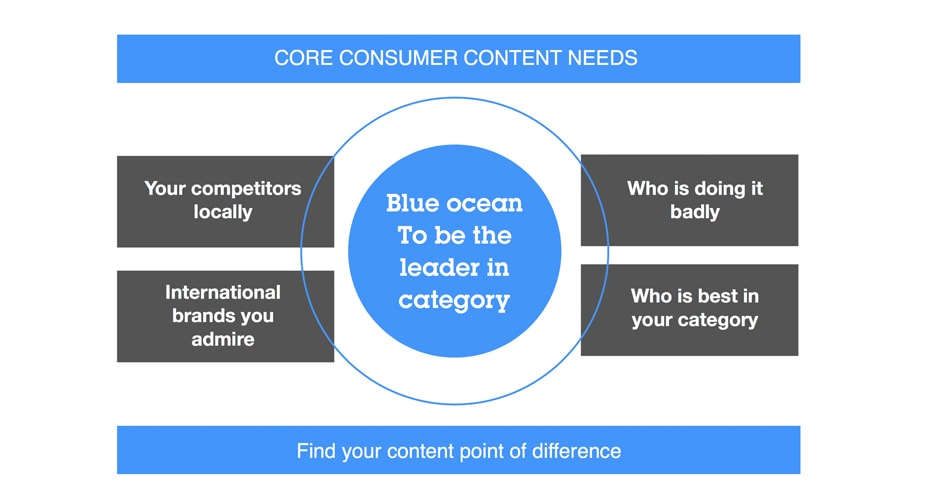
To cut through, content needs to have the consumer at the heart and be built around strong insights and brand truths, but also there are always opportunities to disrupt what the pack is doing and cut through with hero content campaigns that don’t look like or take the same narrative as your competitors.
It also seems that the higher the price point the less risk adverse brands are:
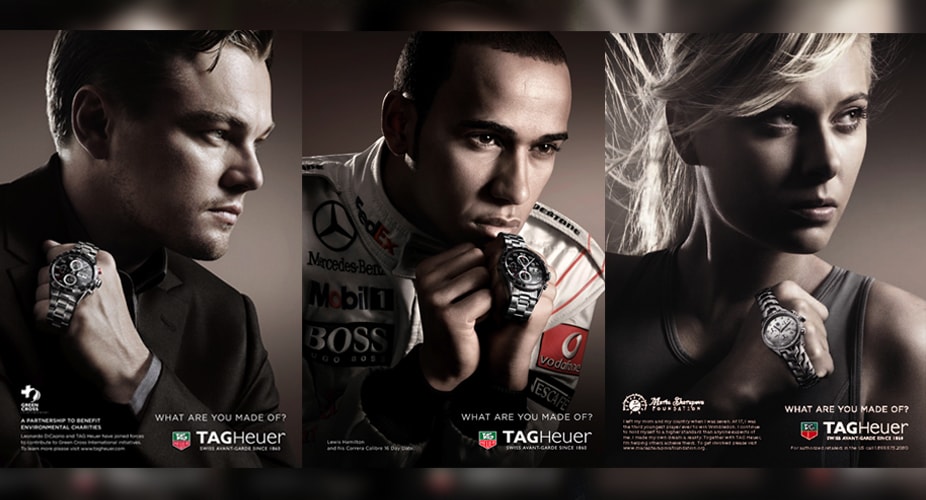
Jewellery – great looking model or celebrity with a piece from the brand.

Cars – highlight the car in aspirational location or escaping with the family, beautiful exterior shots, internal shots showing the instrumentation and cut to the driver and or family enjoying the experience.
That’s why we love this new piece of work from The Wieden+Kennedy team in Tokyo, who decided to leave the car clichés in the bin with their latest campaign for Audi Japan. Instead of they opted for an approach that tunes into emotion and headspace – leaving shots of the A7 Sportback and A8 till the final seconds of the two spots.
And of course, travel:

Panoramic destination shot, authentic experiences and people slightly more aspirational than me enjoying the experience.
Even when it is a must from the client to have some of these attributes, we relish the opportunity to make the content more relatable and not same same.
Recently with Avalon Cruises in a campaign that included TV and a range of content we flipped the thinking to tell the story n the insight that kids don’t believe that their parents could ever be up for having a good time…
We extended the story with personalised film and content to travel agents, asking the agents to help the kids with their homework, and even sent them lunch boxes to make the kids lunch.
The result was Avalon got noticed above and beyond the pack, travel agents engaged in there hundreds through the microsite and a closed Facebook page and sales went up by over 25% year on year.
Yes, we got the obligatory experiences in there, but by looking for a strong insight and telling the story from a fresh perspective, cost effectively gave the brand higher impact.
I’m not saying marketing in Australia is backward, but sometimes I wish brands would think about content differently.
It’s getting better, but when we first started 3rdspace, content was the poor toothless cousin kept in the back shed until the strategy had been dressed up and brought out on display and the ad campaign with its 80% multiple in media had enjoyed all the attention.
A good content strategy aligns very tightly to the brand architecture/DNA from purpose to attributes, values and tone of voice,
A good content strategy has a 1-3 year mission to engage and involve consumers to interact with the brand and take action, including sharing their details with it and purchasing.
A good content strategy aligns to the brand purpose and takes into account all the brand is doing from the inside out, through to partnerships, sponsorships and promotions.
A good content strategy is a 3 year view that has evolving story arcs that should evolve with the market place, how consumers see the brand and the culture/country it lives in.
So why not get onto the content strategy as soon as the business has defined the brand architecture?
It will allow you to:
- Start thinking about the stories you want to tell
- Develop hero content led campaigns that can be tested for engagement, and if resonating strongly refined and taken into traditional media channels.
So get your content out of the back shed and onto centre stage, where it will do your business a world of good.
Rob Logan is the founder and head of content at 3rdspace
Pay for a personality, or create your own?
That is the question.
You’ll notice a couple of pieces of 3rdspace work recently, that uses "a face" for the content.
Our content piece for Pepsi Max to celebrate the 30th anniversary of Top Gun utilises the talents of Chaz Mostert, one of the drivers Pepsi Max sponsor.
The content campaign for NRMA is fronted by the loveable Deirdre, NRMA’s Do it Your Selfer, a character that is unique to the brand.
Both have had fantastic shares and positive sentiment for each brand.
It highlights a challenge many marketers face - to use a known personality that will likely bring instant credibility and social reach to the brand, or create a character that optimises the essence of your brand. Both have merit. Here’s a few thoughts that may help you make the decision on what’s best for your brand.
The Pepsi Max team have done a great job with their sponsorship of Chaz, finding an innovative intellectual property to reinforce the relationship that’s not a sticker on a helmet. The content taps into a wider audience outside of motor racing, and his personality and presence on camera really brings the brand essence to life.
What we learn from this is, if you’re going to do a personality endorsement or sponsorship, build a strong relationship with the talent, find out what the talent is into outside their core known skills and build a story that has wide appeal. Chaz’s fans have loved the clip, and even Holden drivers gave it a like and a share.
If you’re going to create your own personality, the content strategy and back story have to be developed thoroughly before the camera rolls.
NRMA haven’t just used loveable Deirdre as the face of a product campaign, they’ve been open to extending the story and involving consumers in the conversation.
Her personality and how we add to her back story with the content helps build longevity, which is where the challenge is for brand custodians. With so many changes in the market place and within the business they work for, marketers are always tempted to create something new, and walk away from the hard work they have put into developing a character. Other campaigns and characters can come into the mix, but if you have a character who is building a connection with your audience, think about how their story can evolve with your brand.
To share some thinking from my days running media brands, we would allow 2-4 years to build up a personality, knowing it takes time to build a deep emotional connection with the audience. Whether it’s a new show, a media personality or a character for the brand, make sure the personality you create is planned out, just like you’d plan out a campaign. Map out the journey for the character; have them not just selling a product, but living their purpose through the content.
With the right content strategy and innovative evolution of the characters story, your content can pay off bucket loads.
---
Rob Logan is the founder of 3rdspace – where brands with purpose create content of value.

